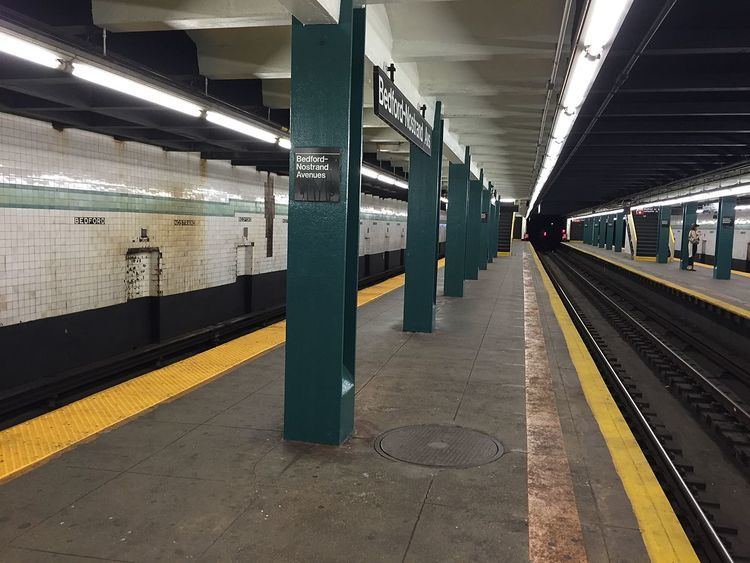Division B (IND) Services G (all times) Opened 1 July 1937 Locale Bedford-Stuyvesant | Line IND Crosstown Line Structure Underground Borough Brooklyn | |
 | ||
Transit connections NYCT Bus: B38, B44, B44 SBS Platforms 2 island platforms
cross-platform interchange Address Brooklyn, NY 11205, United States Similar Myrtle–Willoughby Avenues, Clinton–Washington Avenues, Classon Avenue, Kingston–Throop Avenues, Church Avenue | ||
Bedford–Nostrand Avenues is a station on the IND Crosstown Line of the New York City Subway. Located at Lafayette Avenue between Bedford and Nostrand Avenues in Bedford-Stuyvesant, Brooklyn, it is served by the G train at all times.
Contents
Station layout
This underground station opened on July 1, 1937, as part of the extension of the Crosstown Line from Nassau Avenue to Hoyt-Schermerhorn Streets. This station has three tracks and two island platforms. Both outer track walls have a lime green trim line with a darker green border (formerly crimson red). Below the trim line are small black signs at regular intervals that alternate between "BEDFORD" and "NOSTRAND" in white lettering. Both platforms have green i-beam columns (formerly painted red) on each at regular intervals, with alternating ones having the standard black station name plate in white lettering.
Exits
This station has a full-length mezzanine above the platforms and tracks with staircases to each side at regular intervals that connect the two fare control areas. The full-time one is at the north (geographical east) end. It has a turnstile bank, token booth, and two staircases going up to the western corners of Nostrand and Lafayette Avenues. The fare control area at the south (geographical west) end of the mezzanine is unstaffed, containing just full height turnstiles and two staircases to either eastern corners of Bedford and Lafayette Avenues. The two staircases on the western corners are exit-only and signed as "No Entry". They had been previously boarded-up, with a gate sealing off the passageway towards the stairs.
Middle track and expansion provisions
The middle track is used for storage of rush hour trains, or for maintenance and refuse trains. West (railroad south) of this station, the center track has switches to the two outer tracks before ending at a bumper block, while the trackway continues into Classon Avenue. East (railroad north) of the station, the middle track splits into two tracks that ramp down under the outer tracks before those tracks curve north. The tail tracks continue to Marcy Avenue and end at bumper blocks. A signal and switch tower is located in the tunnel north of the station, staffed during rush hour and midday service, but primarily used during construction reroutes if trains need to be terminated at the station.
Unused in regular service, the middle and tail tracks were originally intended for an unbuilt extension proposed in the IND Second System. Not part of the first official plan in 1929, it was proposed by the city Board of Transportation on October 12, 1930 as an addition to the original plans. The plan was for a line to continue east along Lafayette Avenue to Broadway (at Kosciusko Street of the BMT Jamaica Line), then northeast along Stanhope Street to a junction with the BMT Myrtle Avenue Line and a planned IND Myrtle-Central Avenues Line along Myrtle Avenue (between the Central Avenue and Knickerbocker Avenue stations). The IND would then run east along Myrtle Avenue past the Myrtle El, then along Central Avenue in Queens (as opposed to Central Avenue in Brooklyn) to 73rd Place and Cooper Avenue in Glendale, Queens, adjacent to the Long Island Rail Road's Montauk Branch. The line would have likely continued along or parallel to the Montauk and Rockaway Beach Branches of the LIRR to Rockaway Beach and Far Rockaway. Upon completion of the extension, the center track would have been used to terminate short-run trains, or to provide an additional track to hold trains during peak hours.
